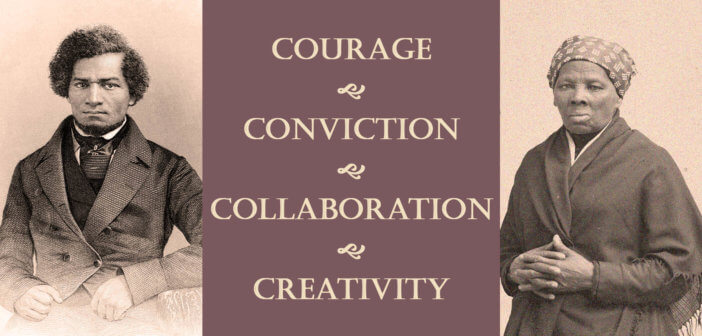Lewis Center Director F. Douglas Powe says that courage, conviction, collaboration, and creativity are four characteristics of effective leadership evident in the powerful legacy of Harriet Tubman and Frederick Douglass. These four “C’s” can also set apart our leadership if we learn to harness their collective power.
What sets a great leader apart from others? What are some of the qualities to look for to help us develop better and stronger leaders? Two historic African American leaders, Harriet Tubman and Frederick Douglass, exhibited four characteristics that set apart their leadership — courage, conviction, collaboration, and creativity. There is nothing magical about any one of these four “C’s.” But the collective energy in harnessing the four together propelled Tubman’s and Douglass’ leadership and it can do the same for our leadership today.
1. Courage
Harriet Tubman was one of the principal conductors of the Underground Railroad that transported individuals from enslavement in the South to freedom in the North. Tubman realized that helping enslaved individuals escape was a life-or-death matter. After she had escaped to freedom herself, she continued to put her own life on the line to free other African Americans. And she organized others to act in a similarly courageous manner, making freedom a reality rather than a pipedream for so many.
Courage requires the ability to define clearly what is at stake, even when others do not want to hear it, and the ability to organize people to do something about it. For congregational leaders, it takes courage to define clearly what is at stake in doing away with traditions that are no longer relevant. But it also takes courage to take the next step and organize people around the necessary changes and move the congregation forward in a new way. Sometimes we are willing to name what is at stake, but then do nothing about it. Other times, we put people to work but fail to name why it is important. Courageous leadership requires both.
2. Conviction
Visionary leaders act with conviction in defense of truths not yet apparent to others. Frederick Douglass was convinced that the United States Declaration of Independence applied to African Americans. The ideals of life, liberty, and the pursuit of happiness were not just for one group of individuals. Douglass used the Declaration of Independence as a way of talking about what it meant to be an American, even though African Americans were excluded. This required conviction.
In today’s environment, effective congregational leaders must be convinced of the need to focus beyond those already in their churches. Even if others in the church are focused inwardly, leaders must maintain the importance of an outward focus. This means talking about ministry outside the congregation as if it were taking place already. This is not a delusion, but an action of conviction in a future that does not yet exist.
3. Collaboration
The importance of collaboration cannot be overstated. No matter how great a leader is, going it alone is a recipe for disaster. Tubman was a conductor of the Underground Railroad, but she could not have helped over 300 slaves escape without the help of others. Many others sacrificed in service of Tubman’s goal of helping slaves escape to the North.
Collaboration is also critical for congregational leaders. Getting others involved in the ministry keeps the workload from falling on the shoulders of just one or two people. It ensures the ongoing success of the ministry even when individual leaders come and go. While one person may be the “conductor” like Tubman, the sacrifice of many shapes the success or failure of a ministry.
4. Creativity
Creativity is not always a matter of inventing something new. Creativity can be a matter of helping people see things in a different light. One of Douglass’ most famous speeches was “What to the Slave is the Fourth of July?” The creative genius of this speech was using the celebration of freedom by white Americans to shine a light on the bondage of other Americans. Douglass’ creative juxtaposition of freedom and bondage helped many see the irony of slavery. In this speech and others, Douglass help Americans see the issue of slavery in a different way. He still highlighted the evils of slavery, but his message was heard differently because of his creative messaging.
Congregational leaders, as well, must employ creativity to help others see things differently. For example, it is not enough simply to say, “We are struggling financially.” Parishioners can simply deny the truth or wallow in the challenges unless a leader helps them see things from a different angle and points to a creative way forward.
Courage, conviction, collaboration, and creativity are four characteristics of effective leadership evident in the powerful legacy of Harriet Tubman and Frederick Douglass. These four “C’s” can also set apart our leadership if we learn to harness their collective power.
Related Resources
- 3 Leadership Principles from Archbishop Tutu by Doug Powe
- Martin Luther King Jr.’s 4 Key Principles of Prophetic Witness by Tony Hunt







